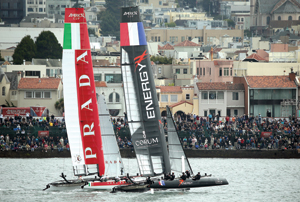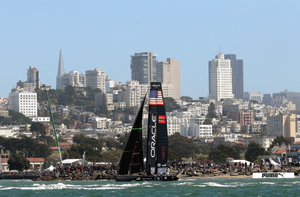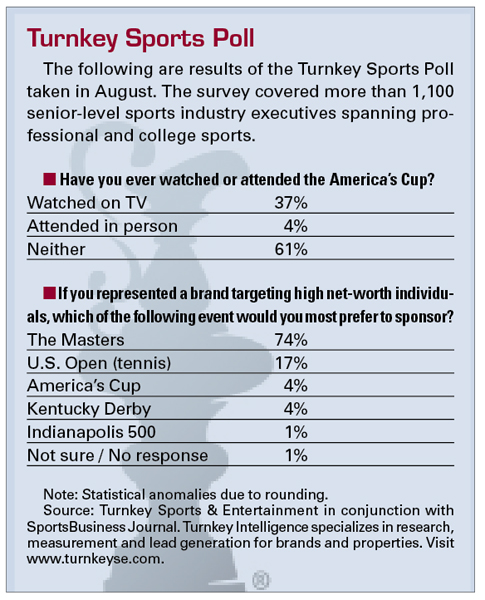On a Friday in late August, a group of eight representatives from four America’s Cup sailing teams gathered at San Francisco’s Embarcadero at the request of organizers of the 2013 America’s Cup. The organizers introduced three members of their advisory board — Harvey Schiller, Jay Cross and Geoff Mason — and ceded the floor to them.
Schiller, the former president of Turner Sports and executive director of the U.S. Olympic Committee, spoke first. He ran through a series of slides that showed the rights fees and sponsorship revenue generated by sports ranging from golf to tennis to mixed martial arts. He said that sailing had fallen behind sports that it once had been more popular than.
 |
The new AC72 catamaran allows racing close to shore, like in San Francisco last month, making the sport more appealing to fans, networks and sponsors.
Photo by: GETTY IMAGES
|
“You have the long tradition of the Cup, great athletes and significant interest in what you’re doing, but we can’t wait until 2013 until there’s the same or a new defender to plan 2013 and beyond,” Schiller said. “We have to do it now. If we work on [creating a series of events] now, we can return America’s Cup to a tier one sport.”
Schiller’s words addressed the challenge that has limited the potential of the America’s Cup and the sport of sailing for decades. The competition is one of the most respected and recognizable properties in the world, but its structure — which gives the winner of the quadrennial event the right to pick the next location and organize the competition — means that it’s struggled to develop a predictable schedule, sell TV rights and land sponsorship.
It’s something that organizers of the 2013 America’s Cup want to change. They’re working with an advisory board, which also includes Peter Ueberroth and Casey Wasserman, to develop a case for creating an international sailing league with 12 to 14 annual events, an array of corporate sponsors and TV partners around the world.
The meeting that Schiller led was one of the organizers’ early efforts to get existing America’s Cup teams to buy into the idea.
“There aren’t many sports properties in the world that have a real chance to be a global sports property,” said Stephen Barclay, CEO of the America’s Cup Event Authority, which is managing the 34th America’s Cup that will be held in San Francisco in September 2013. “We have the resources here backing us. The next six months will determine if we deliver on the vision, and that’s exciting to be a part of.”
The resources and the vision come from billionaire Larry Ellison, who won the 33rd America’s Cup in 2010. The victory gave him control over the event the last two years, and he’s used that period to re-evaluate professional sailing and alter the America’s Cup rules and structure, and to create a popular, less expensive and more commercially viable property.
During the last three years, his Oracle Racing team has created the America’s Cup Event Authority to sell and promote the event, and America’s Cup Race Management to oversee the competition. The organizations are independent, and the hope is that the winner of the 34th America’s Cup hires them to run the next competition, which Barclay said would give the sailing championship the type of organizational stability it has lacked.
 |
Oracle Racing, owned by billionaire Larry Ellison, hosts the next America’s Cup.
Photo by: GETTY IMAGES
|
The team developed a standard boat (the AC72 catamaran) with a winged sail that can maneuver at top speeds of 50 mph and sail in a variety of weather conditions, making it possible for networks to commit to showing races live without having to worry about postponements for weather. Perhaps, most importantly, the boats can race just off the shoreline within view of spectators rather than 20 miles from shore where past races were held.
Finally, it created a series of lead-in races called the America’s Cup Series. Races have been held during the last year in Cascais, Portugal; Plymouth, England; San Diego; Naples, Italy; Venice, Italy; Newport, R.I.; and San Francisco.
The collective changes are expected to increase the size of the audience watching the America’s Cup in person and on TV in 2013, which Barclay said will make it easier for teams to deliver a return on investment to sponsors that range from Emirates to JPMorgan. But more changes are needed if America’s Cup teams want to maintain the interest of those viewers and continue to deliver a return on sponsors’ investments.
“For us to be a global sport, we have to have a calendar that represents a global sport,” Barclay said. “We need a dozen or 14 events a year. That’s the next nut we need to crack.”
Ellison and the America’s Cup Event Authority are trying to get teams to buy into a professional league of sorts. The idea would be for the America’s Cup Event Authority to create a series of a dozen annual races between the 34th America’s Cup and the 35th America’s Cup. It would sell TV rights and sponsorship worldwide to those events. Then it would share the revenue with teams, which spend $30 million to $100 million to compete in the America’s Cup, and use it to cover the cost of organizing the 35th America’s Cup, which is expected to cost more than $100 million.
It’s a radical idea in the world of sailing. The America’s Cup competition is governed by a single piece of paper called the Deed of Gift that was written in 1852, the year after the first race was held around the Isle of Wight.
Historically, the event has functioned on the old cliché: To the victors go the spoils. If teams agree to create a league, though, the victor no longer would control the entire America’s Cup. It would only determine the location of the next competition.
“It’s a really tricky [proposal] given that there’s a 160-year-old sheet of paper 1 1/2 pages long that governs America’s Cup,” Barclay said. “That [piece of paper] is what we’re all about. Otherwise, we’d lose the mystique. But bringing it into the 21st century, keeping the best things of the past, the challenges from countries, creates opportunities to solve the challenges we’re trying to solve, which is putting teams on sound financial footing.”
Several of the teams have been supportive of that idea.
Kim Dong-Young, CEO of Team Korea, said that the team has struggled to get sponsorship since it decided to challenge for the Cup earlier this year. Kim said that the team has met with several sponsors who want to cut a multiyear deal and want to know how many races the team will sail after the 34th America’s Cup is held next year.
“As a small and new team, the idea [of a league] is great,” Kim said. “With the America’s Cup, there isn’t any certainty. For a new country and people without any background, it’s hard to understand. This is a good idea.”
Ben Ainslie, the British Olympic gold medalist, agreed. He recently launched an America’s Cup Series team and plans to challenge for the 35th America’s Cup.
“It’s right the holder [of the Cup] should be able to decide the venue,” Ainslie said, “but if you have an annual circuit, that gives teams the continuity they’re searching for from a commercial standpoint and can give the holder of the America’s Cup the right to hold the event in the venue of their choosing. It becomes much better for everybody.”
Of the three other challengers for the 34th America’s Cup, Patrizio Bertelli, CEO of the Italian team Luna Rossa, declined to comment, saying the team was still learning about the America’s Cup Event Authority’s idea; Paul Cayard, CEO of the Swedish team Artemis Racing, was traveling and unavailable but has supported the idea; and Grant Dalton, CEO of Emirates Team New Zealand, declined comment.
Barclay said that organizers will meet with teams again in San Francisco this October. It’s unclear how many of the five America’s Cup teams and eight America’s Cup Series teams would need to support the idea for the America’s Cup Event Authority to move forward with it. If it wanted, the event authority could move forward with plans without team support and teams could challenge them in New York court, which has jurisdiction over the Deed of Gift.
For now, though, Barclay is intent on building support. In the interim, his team will begin gauging TV networks’ interest in buying rights to future events, sponsor interest in supporting the future “league,” and developing a tentative schedule and finding venues for future America’s Cup Series races.
It already has met with NBC and Mason, who is on its advisory board, and is a producer at ESPN, and it has held conversations with existing sponsors about its plans. But drafting a schedule may be the biggest challenge.
Unlike Formula One, which flies cars from race to race, America’s Cup teams have to spend time sailing from race to race. That creates major logistical issues, Barclay said.
“We’ll have to go to four, possibly five regions of the world and stay there for a period of time and have three or four events there,” he said.
Barclay said that the series has a finite timeline for creating a league — by the America’s Cup next September.
“The worst case for us is we reach the end of the 34th America’s Cup and we do not have sponsors locked in, we do not have venues come in and we do not have a television deal,” Barclay said. “History will repeat itself. The important thing is that the [America’s Cup] winner has in place world series venues, sponsorship deals and television deals. In all of those cases, we can manage those contracts. The trick is how we share the revenues.”






